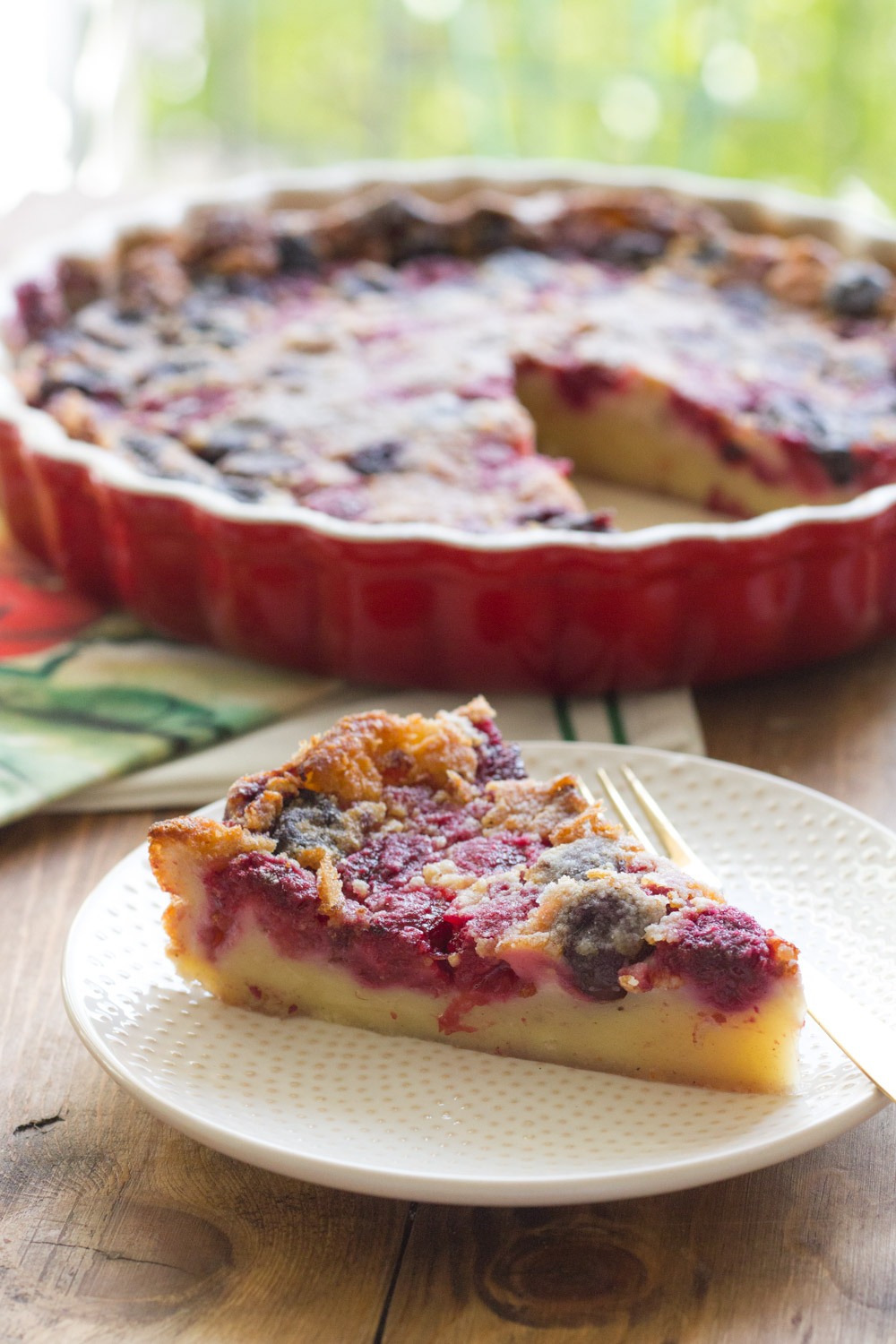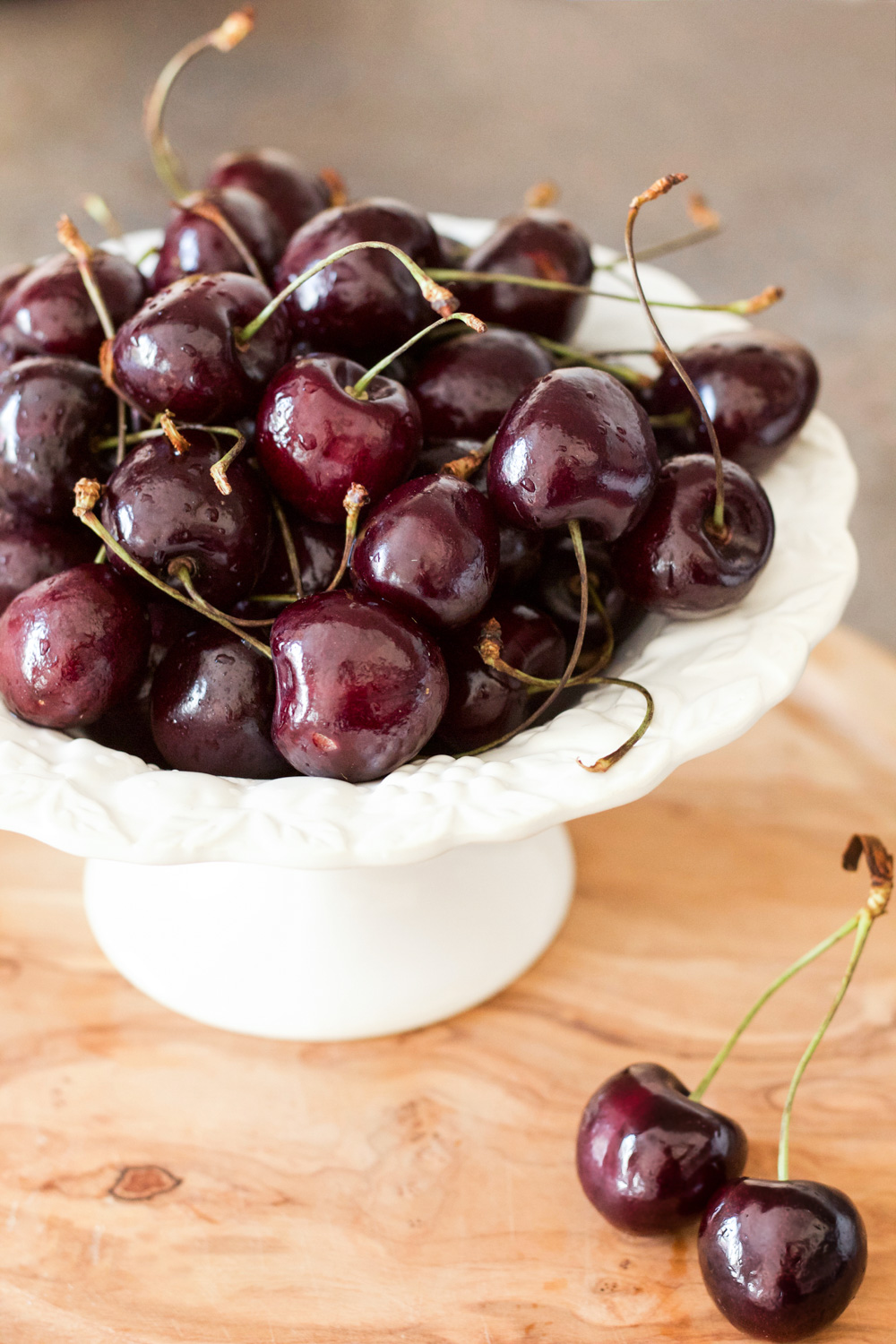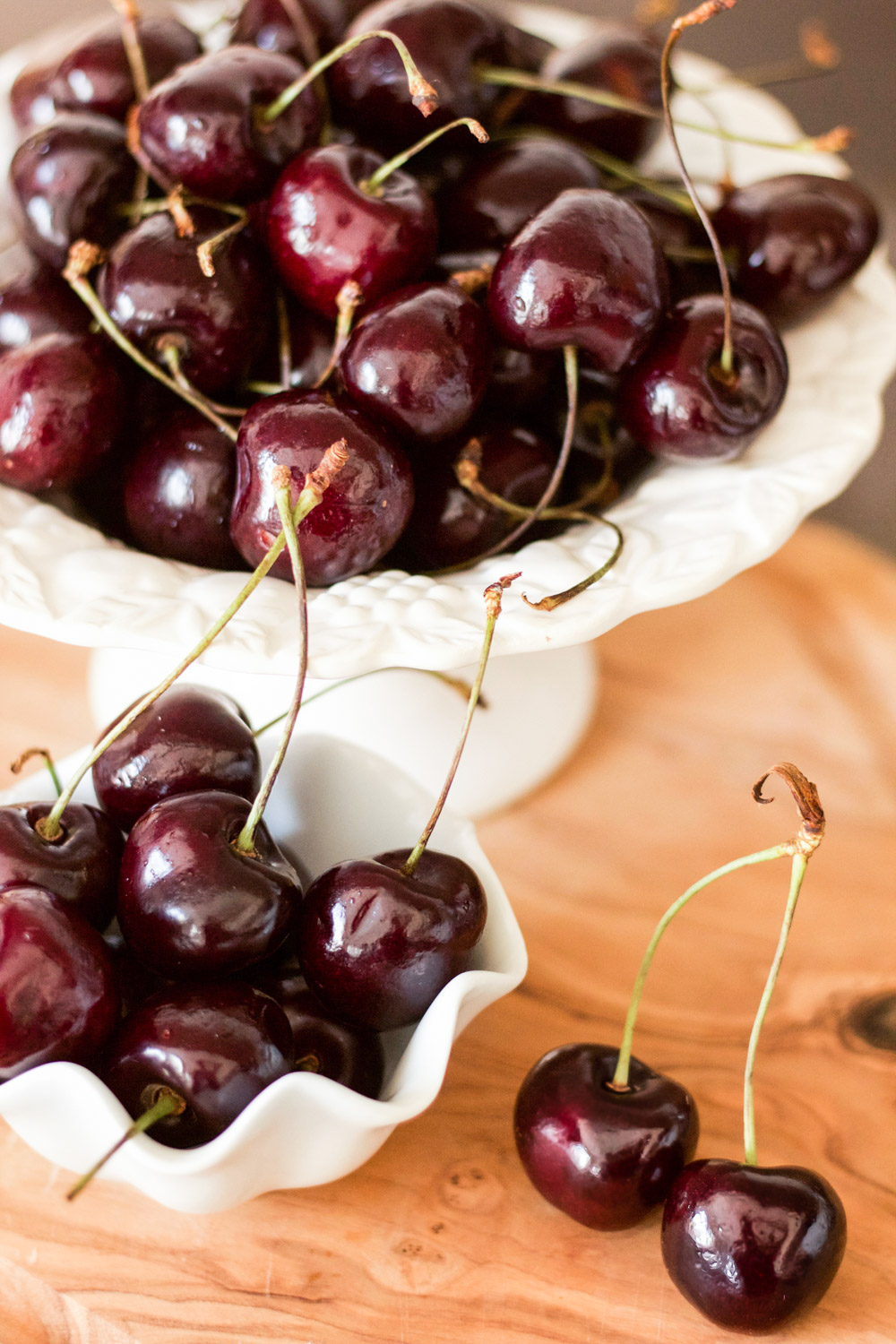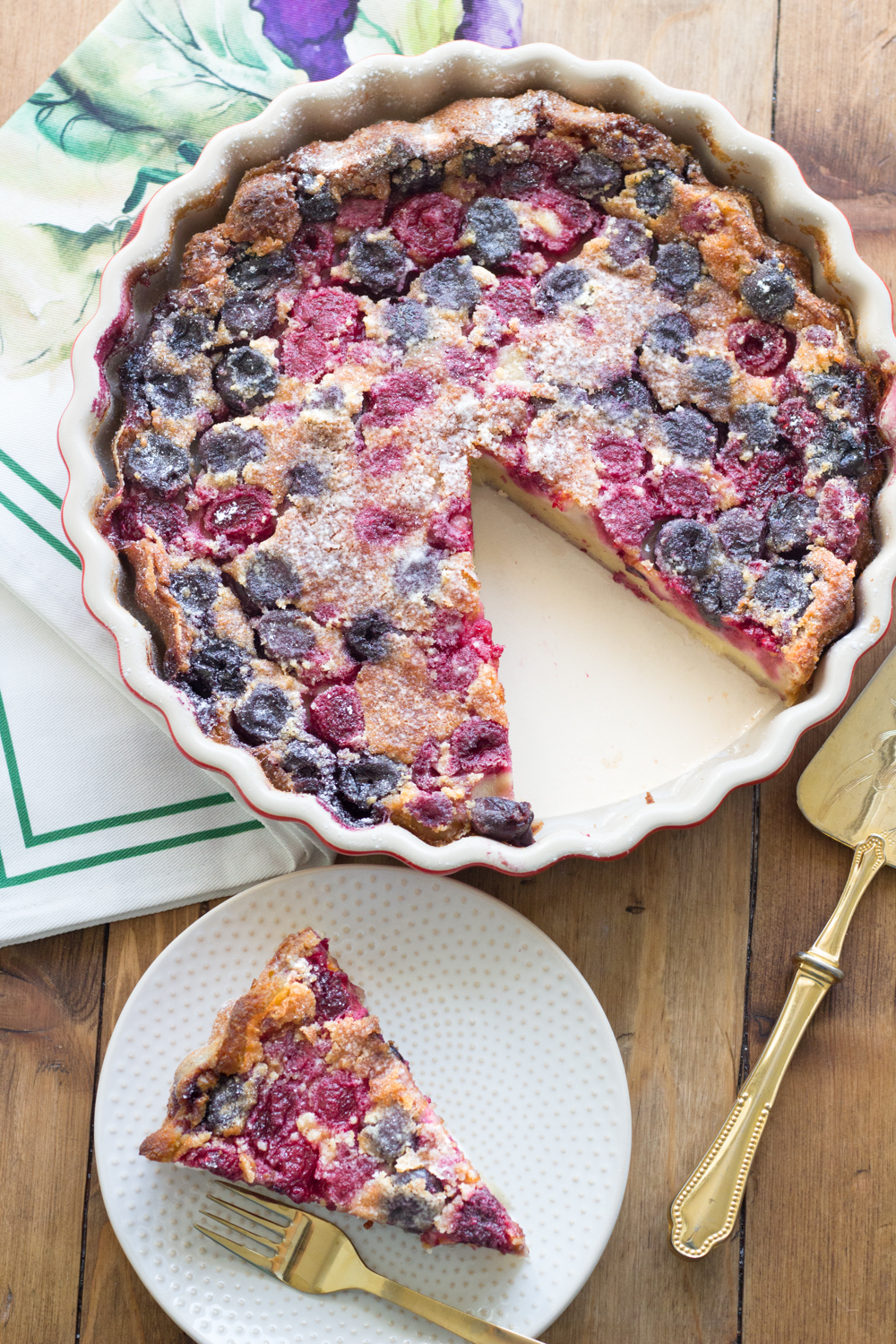Clafoutis: Epitome of easy French summer desserts
Few desserts scream of summer quite like Clafoutis does. This very simple yet elegant dessert is made in a jiffy and is simply perfect for a warm summer evening surrounded by friends and family.
Hailing from Limoges in Central France, Clafoutis definitely holds a very dear place in the hearts of its inhabitants, just like their famous and stunning porcelain or Auguste Renoir, another illustrious Limousin.
But be warned, before I even attempt to describe this wonderful “dessert” I must tell you about the incredible controversy surrounding its definition and how not so long ago l’Académie française had the misfortune of being confronted by the wrath of Limoges.
L’Académie française is THE council that presides over all things pertaining to the French language. This council traces back its origin to 1635 when it was established by Cardinal Richelieu. Normally any ordinance or regulation, definition or derivation decided by this council is as good as law for all French speakers. But not for Limouisins.
The story goes on to say that circa 1960 all hell broke loose when l’Académie Française had the audacity of defining Clafoutis as “sort de flan aux fruits” “a type of fruit flan”.
The horror.
Unbelievably a series of protests erupted in Limoges, violent enough that l’Académie française finally decided to bow down and promised to redefine Clafoutis in the next addenda to their 9th edition dictionary as a “gâteau aux cerises noires”, “cake with black cherries”.
Just as a side note the Académie Française has been “busily” writing their 9th edition dictionary since 1988; yet haven't yet managed to keep their promise to Limousins, as the website still defines clafoutis as “sorte de flan aux fruits” I guess they just haven’t had enough time to get around to it.
But why the protests? Well according to the rest of France, nothing really happens in Limoges. Factually speaking it is one of the least populated areas in the whole of France. So naturally, when the good people of Limoges saw their much-loved dessert be denigrated to the status of flan they really took it to heart. I can understand through that porcelain making and cattle rearing might not be as scintillating as picking up a fight with the governing organism of the French language.
Side note aside, I have to say that I kinda agree with the Académie’s polemical definition. But that also has to do with the way that I view cake (or any other non-French person for that matter). Well, Cake can be defined a baked concoction comprised mainly of flour, eggs, butter, sugar, sometimes milk and flavorings in a certain proportion that when made correctly should render you a moist mostly spongy CRUMB that can be either enjoyed as is or frosted, filled, etc.
The French, however, being the French, have a broader sense of what cake and gateau actually is: they define it as basically ANY baked good filled with or without creams (ie pastry cream, Chantilly creams, etc), fruit, mousse or chocolate. See definition below.
Gâteau: n.m. Pâtisserie, réalisée à partir de pâtes de base utilisées seules ou avec l'adjonction d'appareils complémentaires.
I remember a conversation I had with my very adorable soon-to-be mother-in-law not so long ago. She was questioning why American (from Alaska to Patagonia) and British home cooks and bakers always default on what she considered to be slightly “lackluster” cakes made out of layers of sponge filled and frosted with some form of buttercream to celebrate birthdays when they could create slightly more fanciful gateaux.
I couldn’t for the life of me understand at the moment what she was saying, as much to my dismay she considered eclairs and other bits of pastry items pieced together as a pièce montée suitable as a celebratory cake. Go figure.
But I digress and should come back to Clafoutis.
So we have established that Clafoutis is a very traditional dessert. It is made out of a baked custard thickened with a couple of tablespoons of flour and filled with an abundance of fresh seasonal cherries. The batter is actually not quite dissimilar to that of crepes, the famous Bordelais cannelé or even a dutch baby except for the baked fruit bit.
Purists argue that the only black cherries are to be used in this “gateau”, but if unavailable Montmorency cherries (sour cherries from the Montmorency forest) will do, but that whatever cherry you decide to use it MUST remain unpitted. Clafoutis experts claim that when cooked the pit will release a subtle bitter almond flavor that will impregnate the dish as cherries pits, like the kernels of all other fruits of the almond family, contain amygdalin; the chief component in almond extract.
I honestly think that maybe purists are maybe lacking the time to pit the cherries. They might be helping the Academie Française compile the famous dictionary, who knows.
Now I’m not one to usually stray away from tradition, but the idea of chipping a tooth because I ran into a cherry pit while enjoying my otherwise perfectly fantastic Clafoutis makes me cringe a bit. Also having tried it both with pitted and un-pitted cherries I can also assure you that not much of that almond flavor seems to seep through the thick shell that protects the kernel.
That being said I strongly suggest pitting the cherries and maybe adding a dash of almond extract instead, especially if you have children and elderly people enjoying your dessert, or just not keen on a hefty dentist bill. But it is entirely up to you.
So now that we have established the more contemporary story about Clafoutis, where does it come from?
Clafoutis: the origin.
The first written source that mentions the word Clafoutis dates from 1854, however, it is safe to assume that it is a delicious remnant of Medieval and Roman cooking. We will, in my opinion, be forever in debt to roman cooks who through meticulous trial and effort perfected and found the exact ratio of milk, eggs, and sweetness required to produce perfect baked custards. Needless to say, not much has varied in this department since Tiropatina (roman honey custard) delighted the diners of the 1st century AD.
Why would I venture to say such a thing? It just so happens that not only Limoges can boast having a type of “flan with fruits” in their culinary repertoire. In reality, many are the countries who by direct or indirect contact with Roman civilization have a form of baked custard.
But what about baked custard studded with fruit? Well, you can find lots of examples. The French seem particularly fond of cooking fruit into “flans”. Desserts like Brittany’s Far Breton made with exquisite plums, Flaugnarde, Milliard, Cajasse, and Pelhaire (all made with any fruit you can imagine) are just some examples. However I did find one that struck me as particularly curious from Paray-le-Monial; the Cacou, which I have to say is almost identical to Limousine Clafoutis except for basically the name.
Funnily enough in 1972 a group of friends from Paray le-Monial (Parodiens) got together and created “The Brotherhood of the French Cacous” rightful defenders of the Parodien culinary arts and fine dining.
Each year they get together two weekends after Pentecost and parade through the streets showcasing their baked Cacous and local wine each member flaunting a rustic ceramic goblet around their neck symbol of their brotherhood, but very convenient for the foodie festival that will follow. In the end, they all go home diploma in hand but most importantly with the satisfaction of knowing that their culinary heritage remains intact.
This kind of thing is only really seen in Europe.
But back to Clafoutis.
So what distinguished Clafoutis from other similar desserts? The answer to that question is simple: cherries, LOTS of them, like the origin of its name suggests.
Clafoutis is said to have derived from an old Occitan word claufir which means to fill with, which in turn derived from the Latin expression clavum fingere, to fix something with nails (originally from late medieval liturgical texts that describe the Passion of Christ). Many argue that it was by way of its derivation and not the word itself that the name Clafoutis was born, hinting that the cherries were not only placed in un-pitted but with the tiny stalks that once connected them to the tree still attached to them sticking out of the desert.
To further understand the cherry fuss relating to Clafoutis, it is crucial to know that they are hands down the favorite fruit of the French. I mean can you blame them? I personally cannot get enough of them when they are in season.
Cherries are said to have been introduced by Lucius Licinius Lucullus a very famous politician of the late Roman Republic. After having served his country for over twenty years with a genius generalship style that has been considered by many historians and military experts to have been both flawless and impeccable, he was forced into political and military ostracism by his adversaries once he returned to Rome.
Destitute of the honors he should have received for his valiant service, his enemies were not so stupid as to try to seize the spoils he had brought back from the Eastern Kingdoms (roughly modern-day Turkey). Spoils that were said to have been so bountiful that they were impossible to calculate and that not even he knew how much he had.
The retired general demonstrated a keen eye for investment and poured large amounts of money into most about anything he found remotely interesting and profitable exemplifying how Roman public treasure should have been administrated. That included (but is not limited to) architectural projects, the arts, and sciences becoming a well-known patron.
Such was his love for knowledge that he swiftly converted his family estate into a lavish center for learning, complete with an impressive library and sumptuous grounds that attracted the most important thinkers of his time, food and board completely taken care of.
But his more fruitful ventures were actually in the field of agriculture. He was obsessed with fine dining and sustainable farming. Placing him VERY ahead of his time. It is said that thanks to his relentless research into innovative animal husbandry and aquaculture he could provide Romans with a steady flow of food year round. It is said that he was the man responsible for introducing sweet cherries and apricots into Europe, after having enjoyed them abundantly during his Middle Eastern campaigns.
He has also attributed the creation of a wide variety of new cultivars after careful selection of the most fruitful and tastier plants, like one variety of Swiss chard that still bears his name, which oddly enough is one of the most cultivated because of its yields. Also famous were his incredibly refined and ostentatious dinner parties. So much that the word lucullan is now a synonym for all things lavish, luxurious, sumptuous and gourmet.
I wish to believe that maybe the brilliant Lucullus might have finished one his famous banquets with a Tiropatina full of cherries only to awe his guests with this new fruit presented to them.
So how about that recipe…
I have to warn you that a certain “Frenchie” binged on my clafoutis cherries while I wasn't looking. I was too lazy to go out and get some more, so I ended up adding some raspberries in order to fill my baking dish.
I know that many a Limousin must be gasping at the moment, as technically my “gateau” would actually be considered a “Flaugnarde” (a baked fruit flan identical to Clafoutis except for the fact that all fruit are game concerning Flaugnarde).
However, because I did intend it to be filled only with black cherries and it is at least half full of the lovely little stone fruit that I will continue to call it so. Will Limousins rise up in outrage? Only time will tell.

Clafoutis
Very simple yet elegant dessert is made in a jiffy and is simply perfect for a warm summer evening surrounded by friends and family. This delicious dessert requires the bare MINIMAL utensils and cooking skills.
ingredients:
- 4 eggs
- 125 g (1/2 a cup) of sugar
- 80 g (3/4 cups) flour
- 80 g (1/3 cups + 1 tbsp) melted butter
- 150 ml (1/2 cups) milk
- 150 ml (1/2 cups) of heavy cream
- 1 tsp vanilla extract
- 1 tsp almond extract
- Enough pitted cherries to completely cover your dish (approximately 450g or 1lb)
- 1/4 tsp salt
- Extra butter and sugar to coat your baking dish
instructions:
- Preheat oven to 180ºC or 350ºF
- Grease your baking dish with extra butter and sprinkle with extra sugar to coat evenly
- Scatter cherries inside the greased baking dish and set aside.
- Beat eggs with sugar, salt extracts, and flour until well mixed.
- Add the cream and milk and mix until completely incorporated.
- Pour into baking dish.
- Bake for approximately 35 min or until golden brown.
- Sprinkle with powdered sugar and enjoy. Clafoutis is especially good while it is still warm.
Tag @michellebessudo on Instagram and hashtag it #michellebessudo so I can share it with the world!










